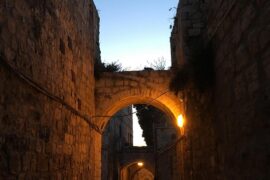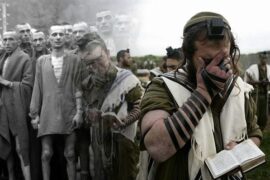Our sages (Baba Batra 121a) gives six reasons for Israel to rejoice on Tu B’Av (the 15th of Av):
1. The “Desert Generation” ended:
Following the Sin of the Spies, when the Hebrews declared that they would not enter the promised land, the entire generation of Israelis who had left Egypt was sentenced to die in the desert. Every year until the 40th year, on the eve of the ninth of Av (the anniversary of the great sin), Moshe would instruct the men to “Go out and dig!”
The people would leave their encampments, dig themselves graves and sleep in them overnight. The next morning, a messenger would proclaim: “Let the living separate from the dead!”
Roughly 15,000 men would have died overnight and the rest would return to the camp for at least another year.
In the 40th year, no one died. At first the people assumed that they had miscounted the days so they slept in their graves another night. This went on until the 15th of Av, when they finally realized the decree had been lifted and they declared that date a day of celebration (Jerusalem Talmud, Ta’anit 4:6).
The reason for the miscalculation had been that they were counting 40 years from the Sin of the Spies but the decree had retroactively began a year earlier when Israel left Egypt.
During all the years of the decree, the Kadosh Barukh Hu did not speak to Moshe directly but only communicated with him through the Urim and Tumim (Ta’anit 30:2). On Tu B’Av of the 40th year, HaShem began to again communicate with Moshe directly.
2. The Hebrew tribes were granted permission to intermarry:
In the first generation to enter Eretz Yisrael and receive their portion of land, Hebrew women who inherited their fathers were not permitted to marry outside their tribe, so as not to allow territory belonging to one tribe to be passed to another. On Tu B’Av, the next generation of women were granted permission to marry whomever they desired from any tribe of Israel.
3. Israel found a way to save the tribe of Binyamin from extinction:
In the civil war between Binyamin and the other Hebrew tribes, Binyamin was nearly wiped out. Only six hundred young men managed to survive. The other tribes had taken an oath at Mitzpe not to allow their daughters to marry anyone from the tribe of Binyamin (Shoftim 21).
When the war ended and the people eventually realized Binyamin to be in danger of extinction, they regretted the oath and looked for a way to help Binyamin survive. It was decided that no one would willingly give his daughter to a man of Binyamin but neither would he prevent one from “running off” with her.
On the 15th of Av, single women would dance in the vineyards near Shilo and men of Binyamin would “kidnap” them with the tacit agreement of the girls and their families – saving the tribe from extinction.
4. Hoshea ben Elah Permitted Pilgrimage to Jerusalem:
King Yerovam ben Nevat, the first leader of the secessionist Kingdom of Israel (which quickly became diplomatically, militarily and economically stronger than the Davidic Kingdom of Judah it broke away from), feared that if Jerusalem continued to serve as Israel’s spiritual capital, it would weaken the legitimacy of his rule. This was largely due to the fact that the holy city was the political capital of Judah and that the law dictated that the only human permitted to sit rather than stand on the Temple Mount was a king from the Davidic line. If Israelis were to ascend the mount on pilgrimage three times a year and see Yerovan standing while his Judean rival Reḥavam ben Shlomo sat, it would lower his stature in the eyes of the nation.
Yerovam sent soldiers to guard the borders between Israel and Judah in order to prevent Israelis from crossing over into Judean territory and visiting Jerusalem (I Melakhim 12). He also established two “alternative” temples with golden calves for Israelis to bring their sacrificial offerings.
Hoshea ben Elah, one of the last kings of Israel, annulled this decree on Tu B’Av, once again permitting the sacred pilgrimage to Jerusalem.
5. Bar Kokhba’s fallen comrades were buried:
The fortress of Betar was the last holdout of the Bar Kokhba Revolt. When Betar fell, on the ninth of Av, 3895 (135 CE), the anti-Roman rebellion was crushed and many thousands of Shimon Bar Kokhba’s fighters were killed. Determined to break Israel’s spirit, the Romans would not even permit the survivors to bury their dead (Gittin 57-58).
In an act of great cruelty, the Romans would not allow the surviving Jews to bury their martyrs for over a decade.
When the dead of Betar were finally brought to burial on the 15th of Av, 3908 (148 CE), it was discovered that the bodies had not decomposed and an additional blessing (הטוב והמטיב) was added to the “Grace After Meals” in commemoration of the miracle (Brakhot 48b).
6. No more trees were cut down for use on the Altar:
The wood used to fuel the Altar at the Temple was dried, since fresh logs might contain worms. After the 15th of Av, the days become shorter and the sun is no longer strong enough to dry out freshly cut logs. Therefore, no more trees would be chopped down after Tu B’Av and the day became known as “Axe-breaking Day” (Ta’anit 31a; Rashi).
This also reminds us of our dedication to Jerusalem. The Talmud tells of our country’s Roman occupiers passing a law that forbade Jews from bringing wood for the Temple’s Altar. The empire stationed guards at checkpoints along the main roads to prevent Jews from approaching the Temple with the logs.
In order to circumvent the decree, brave men made ladders out of the logs and carried them on their shoulders to Jerusalem. When the Roman guards demanded to know where they were headed, they answered: “To bring doves from our dovecotes down the road, using the ladders on our shoulders.” As soon as they passed the checkpoint, however, they would dismantle the ladders and bring the logs up to Jerusalem. These Jews deserve to be remembered as “righteous men of blessed memory” (Ta’anit 28a).
Even under duress and persecution, we remained faithful to Jerusalem and to the Temple service.
All six of the events commemorated on Tu B’Av share one feature in common. On this day, different segments of our people and homeland were united. The generation of the desert ceased to die and the Sin of the Spies was forgiven. Israelis of different tribes were permitted to marry one another. Men of Binyamin were able to marry from other tribes and repopulate following a bloody civil war. The border guards preventing Israelis from coming to Jerusalem were removed. The martyrs of Betar were brought to burial, honoring the memory of those fighters who gave their lives to free our land. Trees were no longer cut down to be burnt on the Altar (the custom of donating logs to the Temple and the Roman determination to prevent it affords another opportunity to illustrate the dedication shown by the righteous even under harsh persecution).
Tu B’Av is very much the opposite of Tisha B’Av. In contrast to the baseless hatred that brought about the destruction of Jerusalem and national exile, the events commemorated on Tu B’Av revolve around love and unity among different sectors of Hebrew society, as well as Israel’s deep connection to our homeland.





